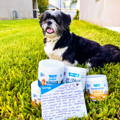Does My Dog Have a Skin Fungal Infection? Signs & Treatment Options
Vet Verified
WRITTEN BY DR. HILLARY WOLFE
Jump to Section

When it comes to your dog’s health, skin issues can be a real worry—especially if you’re unsure about what’s causing the problem. A common but often overlooked issue is skin fungal infections. These can make your dog pretty uncomfortable, leading to itching, rashes, and even hot spots that might need quick treatment.
Understanding what a skin fungal infection is and recognizing the signs can help you address the problem early, keeping your dog happy and healthy.
Different types of dog skin fungal infections
Several types of fungal infections can affect your dog’s skin. Knowing what to look out for and understanding the risk factors can help you treat and even prevent these infections.
Fungal dermatitis
Fungal dermatitis, also known as yeast dermatitis, is one of the most common fungal infections in dogs. It’s caused by an overgrowth of yeast, specifically Malassezia, which normally lives on your dog’s skin in small amounts. When something disrupts the balance of the skin’s natural microbiome, such as food or environmental allergies, this yeast can take over.
Overgrowth of Malassezia can lead to irritation, redness, itching, and a not-so-pleasant smell. Dogs with floppy ears or skin folds are especially prone to developing this condition.
Blastomycosis
Blastomycosis is a more serious fungal infection caused by inhaling spores of the Blastomyces dermatitidis fungus, which is found in soil and decaying organic matter. Once inhaled, the spores can travel from the lungs to the skin, where they cause lesions, ulcers, and nodules.
Aspergillosis
Aspergillosis is another fungal infection caused by the Aspergillus fungus, commonly found in soil, hay, and dust. Dogs usually get this infection by inhaling the spores, which can lead to localized infections in the nasal passages or, in more severe cases, systemic infections. If the infection spreads to the skin, it can cause lesions and ulcers.
Cryptococcosis
Cryptococcosis is caused by Cryptococcusneoformans, a fungus found in soil and pigeon droppings. Dogs typically get this infection by inhaling spores, which can lead to respiratory symptoms and, in severe cases, skin lesions. Dogs with weakened immune systems are at a higher risk for this infection.
Candidiasis
Candidiasis is a fungal infection caused by Candida species, particularly Candida albicans, a yeast that normally lives in the gastrointestinal tract and on mucous membranes. When the balance of normal flora is disrupted, Candida can overgrow and lead to skin infections. This condition often shows up as red, itchy, and moist skin lesions.
Histoplasmosis
Histoplasmosis is a fungal infection caused by inhaling spores of the Histoplasma capsulatum fungus, often found in soil contaminated with bird or bat droppings. While it primarily affects the lungs, it can spread to the skin, causing ulcers and nodules.
What causes dog fungal skin infections?
Fungal skin infections in dogs are caused by various types of fungi that invade the skin, usually when the skin’s barriers are compromised. A healthy immune system generally keeps these fungi in check, but certain factors can increase your dog’s risk.
Environmental factors play a huge role in fungal infections. Warm, humid conditions are perfect for fungi to thrive. Dogs that spend a lot of time outdoors, especially in moist soil or areas with decaying organic matter, are at a higher risk of exposure.
Dogs with underlying health conditions like allergies, diabetes, or a weakened immune system are also more susceptible to fungal infections. Additionally, certain medications, such as corticosteroids or other allergy medications can suppress the immune system and increase the risk.
Poor grooming habits or infrequent grooming can also contribute to the development of fungal infections. Matted fur is the perfect place for moisture to accumulate, allowing the overgrowth of fungus and other microorganisms. Regular grooming, appropriate for your dog’s coat type and lifestyle, helps maintain a healthy skin barrier and prevents the buildup of dirt and moisture where fungi can grow.

Signs & symptoms of dog skin fungus infections
Recognizing the signs and symptoms of a fungal skin infection in your dog is crucial for catching it early. Symptoms can vary depending on the type of fungus and the severity of the infection, but there are some common signs to watch for.
Persistent itching and scratching are among the most noticeable symptoms. You might also see red, inflamed skin that looks sore and irritated. In cases of fungal dermatitis, the skin may have a greasy or scaly texture, and there could be an unpleasant musty odor. Other symptoms include hair loss, crusty or thickened skin, and the presence of ulcers or nodules.
Systemic fungal infections, such as blastomycosis or histoplasmosis, can cause more severe symptoms like lethargy, weight loss, fever, and respiratory issues. If the infection spreads to the skin, you might notice slow-healing lesions or ulcers. If you spot any of these signs, it’s important to get your dog checked out by a vet as soon as possible.
How are dog skin fungal infections diagnosed?
Diagnosing a dog skin fungal infection typically involves a physical exam, diagnostic tests, and a review of your dog’s medical history. Your vet will start by examining the affected skin areas, looking for visible signs like redness, hair loss, or lesions. They might ask about your dog’s environment, grooming habits, and any underlying health conditions.
To confirm the diagnosis, your vet may collect a sample from either a skin scraping or impression smear (pressing a glass slide onto the skin to collect cells). This will then be examined under a microscope to determine if there is a fungal overgrowth. They may even recommend collecting a larger piece of tissue (biopsy) to send out to the lab.
These tests help identify the specific type of fungus involved, which is crucial for determining the most effective treatment plan. In some cases, blood tests, urine tests, or imaging studies might also be needed to assess the infection’s extent and check if it’s spread to other parts of the body.
How are dog skin fungal infections treated?
The treatment for fungal skin infections in dogs depends on the type and severity of the infection. Mild cases of fungal dermatitis can often be treated with topical antifungal medications, such as sprays, wipes, creams, ointments, or shampoos, applied directly to the affected areas. For more severe infections, your vet may prescribe oral antifungal medications to help clear the infection from within.
Systemic fungal infections, like blastomycosis or histoplasmosis, require more intensive treatment. These infections often need long-term oral antifungal therapy—sometimes for several months—to ensure the infection is fully treated and eliminated. Additional supportive care, such as pain management, anti-inflammatory medications, or intravenous fluids, might be necessary to manage symptoms and complications.
During treatment, it’s important to follow your vet’s instructions carefully and complete the full course of medication, even if your dog’s symptoms seem to improve. Stopping treatment too soon can lead to a recurrence, which may be harder to treat the second time around.
Tips for preventing dog skin fungus issues
Preventing fungal skin infections in dogs involves good hygiene, regular grooming, and environmental management. Keeping your dog clean and dry is key to preventing fungal growth. It is also important to identify any possible underlying allergies (food or environmental) and pursue the proper treatment, as allergies can predispose your dog to a fungal infection.
Regularly check your dog’s skin and coat for any signs of irritation, and keep their living environment clean and dry. If your dog spends a lot of time outdoors, especially in areas with moist soil, be sure to wash and dry them thoroughly afterward.
In regions where certain fungal infections are more common, such as areas prone to blastomycosis or histoplasmosis, consider limiting your dog’s exposure to environments where these fungi are likely to be found.
You can help protect your dog from the discomfort and health risks associated with fungal skin infections by staying vigilant and maintaining good grooming and hygiene practices. Regular vet check-ups and prompt attention to any skin issues will also go a long way in keeping your dog healthy and happy.
Join the Pack!

Sign up for exclusive deals, curated pet tips from veterinarians, and product launches!
Pet Parents are Also Reading
October, 2022
May, 2023
April, 2023
Yeast Infection on Dog's Skin: Causes & Treatments
July, 2024
Written By a Vetnique Vet

Dr. Hillary Wolfe, DVM, CVFT
Dr. Wolfe is a traveling veterinarian and the owner of Tula Veterinary Nutrition. She is passionate about enhancing pet health and longevity through food, with a strong focus on natural nutrition and homemade diets.
Sign up for exclusive deals, curated pet tips from veterinarians, and product launches!
























